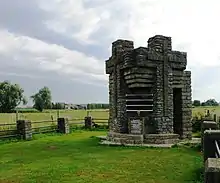Van Raemdonck brothers
Edward and Frans Van Raemdonck were siblings who were killed while serving in the Belgian Army in World War I and who became prominent in Flemish popular mythology after the conflict. Born in Temse in East Flanders, the brothers had volunteered for the Belgian Army in 1914 and were serving together in the 6th Company of the 24th Line Regiment (24. Linieregiment) when they were killed in an attack on the hamlet of Stampkot, near Steenstrate, on the night of 25–26 March 1917, aged 18 and 17 respectively. In the aftermath of the conflict, the deaths of the "Van Raemdonck brothers" (Gebroeders Van Raemdonck) became part of Flemish popular mythology as a result of its symbolism of brotherly love and self-sacrifice. Their flamingant views and the supposed indifference to their fate among their French-speaking officers meant that it became increasingly associated with the Flemish Movement in post-war Belgium. Their fate was widely commemorated in monuments over following years and the brothers were symbolically reburied at the Yser Towers (IJzertoren) monument in 1932 and was an important part of the annual Yser Pilgrimage (IJzerbedevaart).

Further reading
- Shelby, Karen (2014). Flemish Nationalism and the Great War: The Politics of Memory, Visual Culture and Commemoration. London: Palgrave Macmillan. ISBN 9781137391735.
- De Ryck, Luc (1997). Terug naar niemandsland. De geschiedenis van de gebroeders Van Raemdonck: mythe en werkelijkheid. Koksijde: Klaproos.
External links
- "In elkaars armen gestorven", de broers Van Raemdonck at VRT
- Edward and Frans Van Raemdonck at the Nieuwe Encyclopedie van de Vlaamse Beweging.